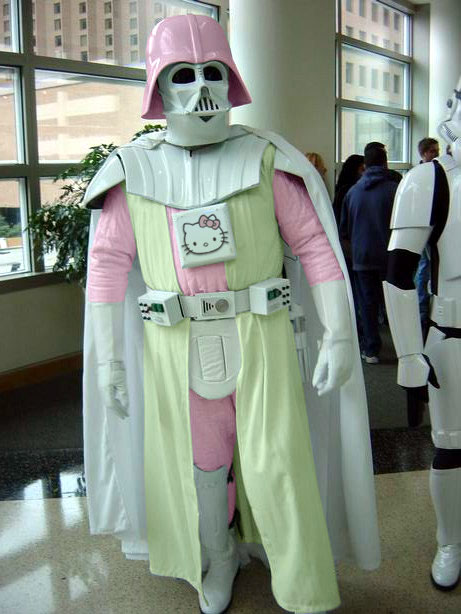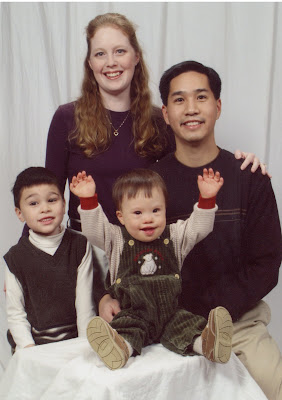This past weekend for our anniversary, Ellen and I saw the musical
Wicked, which was very well done. It was a fascinating homage to
The Wizard of Oz, doing a bit of postmodern deconstruction of the traditional story but also reconstructing the narrative in such a way that created a great cultural artifact of its own. Ellen and I love musical theatre - we've seen
Les Miserables, Phantom of the Opera, Miss Saigon, Joseph, The Lion King and others. Below is an article I wrote for a denominational magazine some years ago about what Christians can learn from Broadway musicals, especially in terms of worship.
What Christians Can Learn from Broadway
by Albert Hsu
Balcony seating, third row. For three hours I sat transfixed as the stage before me was transformed into 19th century France. The set itself seemed alive as the actors personified Victor Hugo’s grand themes: poverty, revolution, law, mercy, faith, hope, love, life and afterlife. At the finale, the company sang a prophetic chorus with eschatological imagery anticipating the day that “They will live again in freedom in the garden of the Lord / They will walk behind the plowshare / They will put away the sword.”
This was no mere musical. For me,
Les Misérables was a worship experience and perhaps even a divine encounter.
I exited the theatre exhilarated in emotion and stirred in my spirit. I was convinced that God had met me in a powerful way during the show. What was it about this musical that brought tears to my eyes? Was it the bishop’s forgiveness of a desperate criminal? Fantine’s sacrificial love for her daughter? Eponine’s tragic, unrequited love for Marius? Valjean’s perseverance and commitment to truth and justice? Was it the epic story, the magnificent music, the fabulous set or the rotating stage?
Certainly the content of the show was in many ways theologically sound. The God depicted in
Les Misérables is the God who redeems that which seems worthless in the world’s eyes, a God who accepts repentance, forgives sins and answers prayer. On one level,
Les Miz can be construed as a worship event in that its content was largely orthodox and instilled in me a greater sense of gratitude to our Savior. I feel no qualms about calling “worshipful” a production that called me to a deeper praise of God.
But what of those musicals with seemingly flawed or incomplete depictions of God? What are we to make of
Jesus Christ Superstar, for instance, or
Godspell? While
Joseph and the Amazing Technicolor Dreamcoat does an admirable job of following the Genesis narrative, it neglects to mention God as the author of Joseph’s dreams. Is it then deficient and unworthy of Christian appreciation? Or what of dramas without an explicitly Christian or spiritual theme—
Phantom of the Opera, for instance, or
Evita or
Miss Saigon?
Some Christian theatre aficionados may spiritualize these plays by emphasizing songs like
Miss Saigon’s “Why God Why” as an attempt to make sense of the Vietnam War. Perhaps Eva Peron can be envisioned as a Christ figure, laying down her life for Argentina. Such rationalization seems like a stretch.
But we need not hunt too far to justify a Broadway musical as a worship experience. It is my contention that the medium of musical theatre itself points us to the worship of God.
The Power of Drama
Live stage is one of the few arenas left in society where a drama may be actually experienced and not just viewed. To see a drama enacted on stage brings the story to life in a way far more compelling than watching a movie. At a movie, we are only voyeurs of mere images spliced together on a silver screen, separated from the actors by both time and space. But on stage, those are real live people before us! They breathe the same auditorium air that we do. They hear the same orchestra that we hear. We share the same time and space as the actors, so in a very real way, we participate with them in the drama of the moment.
Thus, live theatre provides a greater sense of authenticity in performance than film or television. There are no retakes on stage. If you make a mistake, it’s there for all to see and you have no choice but to play on. When I saw
Joseph, in one scene the narrator began singing the wrong verse. She actually said, “Oops!” and her hand flew to her mouth to cover an embarrassed grin.
When the narrator broke character, the audience saw her not just as an actress on stage, but a real person like any of us. We chuckled with her and shared her momentary discomfiture and chagrin. Such an occasion resonates with our experience and validates our humanity. It reminds us that all are fallen, no matter how polished a facade we might wish to project. While we may not like being reminded of our faults, we can take comfort in the fact that we are not alone in the human condition.
And so it is in real life, that we don’t have the luxury of reshooting scenes or editing out mistakes. That’s why all the world’s a stage—including our worship. Not only in the sense that what goes on in the context of a worship community is “rehearsed” and “performed,” but also that both worship leaders and worshippers are authentic, real-life people who bring our human foibles and propensity to err to the worship experience.
Furthermore, live theatre invokes the senses in ways a movie or TV show cannot. After all, life is not merely visual and auditory, but tactile and olfactory as well. We not only see real smoke and mist waft across the stage—we sniff the air and rub our noses. We feel the wind of a helicopter’s rotors. We draw back when a chandelier plummets from the ceiling and recoil when fireworks are detonated on stage, afraid that the heat will singe our eyebrows.
All this points to the poverty of our worship when our senses are not fully engaged. We do not experience life in one dimension, but three. We are to love God with both minds and bodies. How sad it is, then, that the worship we offer our God rarely involves anything other than what is mouthed or seen.
The Drama of Worship
Many strands of post-Reformation Christianity largely eliminated the use of the senses in worship. Zwingli whitewashed the walls of the churches, believing the artistic imagery of frescoes and paintings to be unbiblical, even demonic. The burning of incense and the lighting of candles were thrown out as Catholic superstition.
But it was not always so with worship. Think of the pageantry of the Old Testament, where God’s people would rehearse God’s salvific acts at feasts and festivals. They would re-create the Passover and reenact the Exodus in a drama that involved the whole community. They sang and danced to the songs of Moses and Miriam in celebration with harp, lyre and cymbals. No dry Scripture reading, this; the Israelites physically re-experienced God’s salvation anew with each dramatized remembrance.
The passion plays of the Middle Ages similarly enfleshed God’s historic activity in contemporary incarnation. Through actors’ mime and drama, the life, death and resurrection of Jesus took on new life. In this way, Jesus walked not only Nazareth and Jerusalem, but London and Paris as well.
This is something else appealing about live drama—the possibility of interaction.
Joseph’s Pharaoh can toss a scarf to a fan in the front row. Hamlet may leave the stage and wander up and down the aisles. This dynamic may explain the popularity of Renaissance fairs, where modern suburbanites mingle with medieval minstrels and troubadours. We are somehow fascinated by the opportunity to be insulted by a twelfth-century peasant.
Similarly, live drama can re-create for us the experience of being with Jesus. Our worship is impoverished when we think of worship as merely singing a few songs or reading a few verses. It can instead be a living encounter with the Word who became flesh, not merely a voice.
We must remember that Jesus was a true human, whose physical hands touched leprous flesh. Healing and restoration came through his spittle on blind eyes. Life returned to Lazarus when his dead ears heard Jesus call him forth. This Jesus activated his followers’ taste buds by feeding them loaves and fishes, bread and wine. He taught us to taste and see that the Lord is good.
The elements of the Lord’s Supper are by their very nature dramatic and sensory. We do not merely have an intellectual remembrance of Jesus’ work, but somehow, through tasting the bread and drinking the cup, we enter into the experience of those who ate and drank with Jesus.
I once saw
a musical version of the book of Acts. (I regret that I was only able to watch a video instead of experience the live performance.) One significant element was that a jacuzzi-type basin of water was placed at the front of the stage. At every juncture of the book of Acts where a baptism occurred, the actors went right into the water and baptized one another. Those at Pentecost, the Ethiopian eunuch, Saul of Tarsus, Cornelius and his household, the Philippian jailer—all came out of the musical dripping wet! I can only imagine what it was like for those sitting in the front row, to catch some of the spray and to experience in some small way the baptismal joy of the early church.
Perhaps such an appreciation for drama can be rediscovered and applied in the local church in ways more creative than just the occasional skit. Indeed, worship could be as colorful as Joseph’s coat and as profoundly moving as the music of the night.
At a church I once attended, a worship service took place where a person walked around the sanctuary wearing a sign that read “GOD”. The congregation stared in hushed awe; even children stopped fidgeting. All had a heightened awareness that God was in their midst.
This symbolization of the physical presence of God during worship could not have been communicated by mere text or song; it required a dramatic representation. If Broadway has anything to teach Christians, it is that God longs to encounter us in drama, as authentic persons, through all our senses.
And
Les Miz points us to a day where somewhere beyond the barricade lies a world we long to see—a world where the lion lies down with the lamb, where every tear is wiped away, where we will experience the incomparable drama of all creation praising our triune God, crying “Holy, holy, holy.”
I, for one, want a front row seat.






